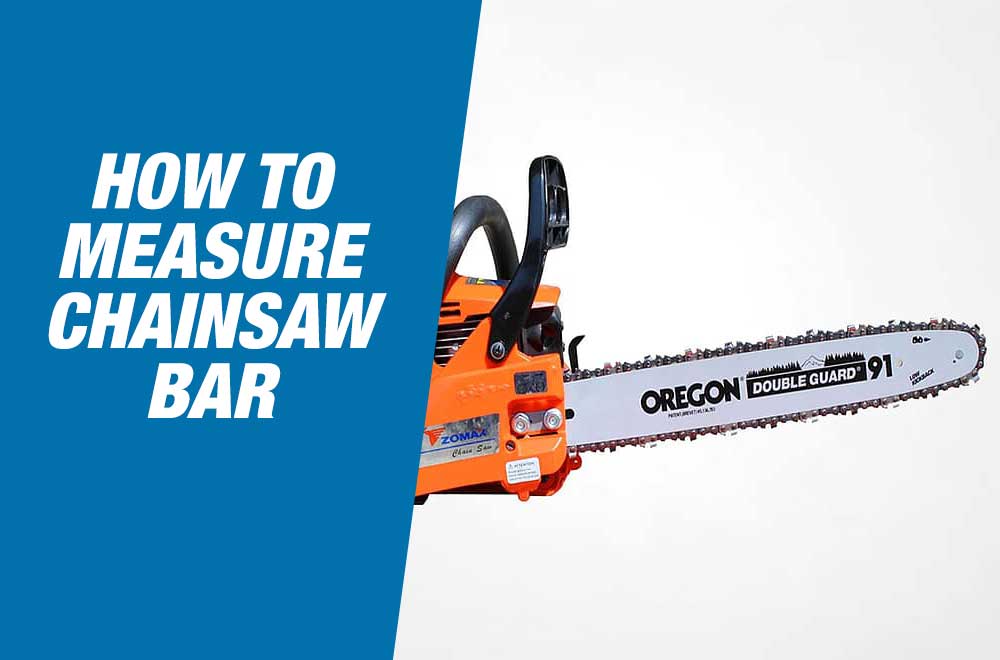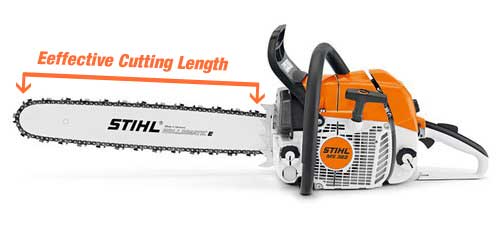The bar of your chainsaw can wear out after a certain period. Even with proper oiling and sharpening, the chain needs to replace. Therefore, you need to learn how to measure the chainsaw bar.
In today’s post, we will discuss with you the simple methods for measuring the chainsaw bar and determining the required length of the chain.
We’ll discuss the measurements of bar and chain, and the main difference between cutting length and actual length, for helping you measure the bar of your chainsaw. First, let’s have a good look at this calculative post!
Chainsaws are one of the most valuable tools for everyone. But, not every bar is perfect for your saw, as larger chainsaw bars will work properly with the power saws.
Moreover, you will be able to get the information you need for replacing the bar in the manual. But if you lose the manual or have to work outside, you will need to do one thing.
It would help if you learned how to measure the chainsaw bar. So, if you understand the proper measurement, you can figure it out quickly.
To make it simple, we will divide this measurement into some points. With no delay, have a good look at this point.

Guide About How To Measure Chainsaw Bar
The Bar

The bar is termed the blade. An elongated bar will need heavy power collecting from the motor. Therefore, you will find shorter bars in cheaper saws because they utilize engines with low power. Significantly few electric chainsaws will go beyond 18 inches in length. And battery-powered chainsaw units are lesser than that.
You have to check the user manual to find out the full-length bar that you can use for the chainsaw. Only the measured size chain can fit with the bar. So, you aren’t required to remove or add any links.
Effective Cutting Length

It is commonly called the length. Effective cutting length calculates the extension between the edge of the bar and the attachment with the saw. For getting this measurement, you have to take the tape or yardstick and then place this at the bottom of the blade and calculate the distance of the edge.
- If you calculated 16¼ inches, you should consider a 17-inch effective cutting length.
- If you calculated 18¼ inches, you should consider a 20-inch effective cutting length.
True Length
It is the bar’s main length, which is taken from the serial before installation. If you didn’t take this calculation before installing the bar, you have to remove this by opening the bolts that occupied it in place. The bolts place just out of the bottom of the bar.
After removing the bar, place this on a leaning surface and take a tape to calculate. Even you can use a yardstick for getting the measurement. You will not round off the numbers here as the effective cutting length.
Consider An Upgrade
If the saw is old and needs a chain and a new bar, you will find it easy to purchase a new chainsaw. But, we will not pinpoint this here.
However, many popular brands are selling their products at an economical price. And, a new one will not cost you much more. Battery power saws are handy. Besides, corded saws are not very expensive. They are lightweight too.
Replacing The Bar
As you take the effective cutting length and the valid length of your bar, you are just required to evaluate the two numbers for a better fit.
Recommended Bar: Oregon 280RNDD025 28
Measurement The Chain Length
It may seem more complicated than measuring the bar if you want to measure the chain length. And it will require you to take and compare two essential measurements: pitch and gauge.
Tips
For taking the first measurement, you have to calculate the number of links from the serial. This calculation can seem strange to you, but it will affect how the chain is going around for bending at the edge and bottom.
If the chain gets the wrong number, it won’t shift across the bar properly. Therefore, it will be jammed up at the bottom.
Pitch
Pitch is the gap between the drive links of the chain. To get this calculation, you must calculate the gap between any three successive rivets.
Then, you have to divide this number into two. Some common pitch values are 3/8, 3/8, and ¼-inch. But some other discounts are attainable.
Gauge
Gauge is the calculation of the groove that will keep the chain of the bar when it cuts. There are some common gauges, such as .043, .050, .058, and .063 inch.
Therefore, you have to know what your one is before purchasing. You can take a tape for measuring the gauge. Or, you can use the penny, dime, or even quarter, if you want to get the most regular gauges.
- If the penny is fitting the snug without any force, then you are determining for a .043 gauge
- If the dime is providing the snug without any power, you are choosing a .058 gauge
- If the quarter is fitting snug without any pressure, you are selecting a .063 gauge
Making It Easy
Most brands always put all the information you need precisely on the bar. You will see this by removing its cover, which is hiding on the end portion of the bar.
If you calculate the bar previously, you will see the numbers which are printed on this. You are just required to correlate these numbers with your package number for getting a perfect fitted chain.
Never Estimate
It would help if you took sufficient time to get the perfect calculation. And never guess or estimate the measurements.
If you do this, then you will waste money and time. Then, you have to deal with frustration. Therefore, you may damage the saw permanently, and injury can occur.
Proper Maintenance Can Reduce The Wear
If you keep well oiled on the chain during work, you can ensure longevity. Some saws have an automatic oiling mechanism.
You have to keep it running wet always. If your saw does not have this system, we suggest stopping the work frequently.
Then put oil into it. Although, most popular saws facilitate the oiling mechanism. This will improve the work experience. In addition, these models have better anti-vibration mechanisms,anti-kickback mechanisms, and fuel efficiency.
Summary
If you have to change the chain, you should remove the cover at the bottom of the bar. Then check it for the number of the pitch, gauge, and chain links.
If the numbers are absent on the bar, you must calculate them by following this instruction. In the case of changing the bar, you have to complete the calculation. If you don’t have the user’s manual, you can find it on the internet.
Conclusion
So, this is all about how to measure the chainsaw bar. We hope you learn about it after reading this article. A chainsaw is an essential tool. And, counting the bar is a vital point for using the chainsaw properly. Happy sawing!
Read More
